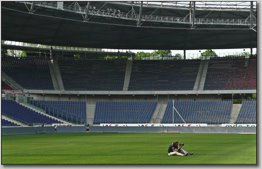This post may be a little longwinded, but I think these photos need context to be understood. Bare with me as I try and keep to the point.
I was invited back into the village in the evening. NOTS had visited the village two days prior to train the locals on using the solar lights. My goal was to document the way the lights were being used at night. I could have done a before and after photo, but the 'before' would have been an even darker frame. Truth is some did have lighting before this introduction to solar. Kerosine lamps and battery powered lashlights work fine. The problem with kerosine is that it produces dangerous fumes inside the home plus it costs at least €1 per week to keep the light working. You can buy kerosine everywhere here. The sellers typically package the liquid in old plastic water bottles. It works, but it's obviously not very safe. The problem flashlights is the batteries. Batteries are not too expensive and are readily available. The disposal is the problem. This village currently burns their waste in trash pits behind their land. Our house is located about a ten minute walk from here and we can sometimes smell the plastic burning. I talked about this with one of my guides in the village. He's studying and spoke a little English. I mentioned that battery waste was a real problem. He said yes, it could be dangerous if the children or sheep ate them.
I was invited back into the village in the evening. NOTS had visited the village two days prior to train the locals on using the solar lights. My goal was to document the way the lights were being used at night. I could have done a before and after photo, but the 'before' would have been an even darker frame. Truth is some did have lighting before this introduction to solar. Kerosine lamps and battery powered lashlights work fine. The problem with kerosine is that it produces dangerous fumes inside the home plus it costs at least €1 per week to keep the light working. You can buy kerosine everywhere here. The sellers typically package the liquid in old plastic water bottles. It works, but it's obviously not very safe. The problem flashlights is the batteries. Batteries are not too expensive and are readily available. The disposal is the problem. This village currently burns their waste in trash pits behind their land. Our house is located about a ten minute walk from here and we can sometimes smell the plastic burning. I talked about this with one of my guides in the village. He's studying and spoke a little English. I mentioned that battery waste was a real problem. He said yes, it could be dangerous if the children or sheep ate them.
Amazing to see first hand how technology can change the ways of a very old and traditional world. Yesterday this village did not have a decent choice for lighting their houses at night. Tonight it seemed to me as if they had never lived without it.
Very challenging to shoot these scenes. Modern lens stabilization technology today lets me shoot in situations I would not have been able get a stable hand held photo just a few years ago. My invitation into this village is fragile at best. I can't show up here with a big tripod and tell everything to sit still for 20 seconds.
It's good to be the chief.







Geen opmerkingen:
Een reactie posten